No edit summary |
|||
| Line 113: | Line 113: | ||
[[Category:Psychological schools]] |
[[Category:Psychological schools]] |
||
[[Category:Psychology]] |
[[Category:Psychology]] |
||
| + | [[Category:gestalt psychology]] |
||
[[Category:Graphic design]] |
[[Category:Graphic design]] |
||
[[Category:Visualization]] |
[[Category:Visualization]] |
||
Revision as of 15:40, 9 May 2006
Assessment |
Biopsychology |
Comparative |
Cognitive |
Developmental |
Language |
Individual differences |
Personality |
Philosophy |
Social |
Methods |
Statistics |
Clinical |
Educational |
Industrial |
Professional items |
World psychology |
Psychology: Debates · Journals · Psychologists
Gestalt psychology (also Gestalt theory of the Berlin School) is a theory of mind and brain that proposes that the operational principle of the brain is holistic, parallel, and analog, with self-organizing tendencies. The classic Gestalt example is a soap bubble, whose spherical shape (its Gestalt) is not defined by a rigid template, or a mathematical formula, but rather it emerges spontaneously by the
parallel action of surface tension acting at all points in the surface simultaneously. This is in contrast to the "atomistic" principle of
operation of the digital computer, where every computation is broken down into a sequence of simple steps, each of which is computed independently of the problem as a whole. The Gestalt effect refers to the form-forming capability of our senses, particularly with respect to the visual recognition of figures and whole forms instead of just a collection of simple lines and curves.
Emergence
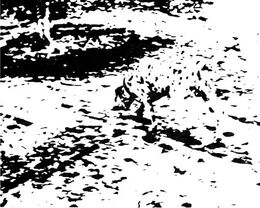
Emergence
The key properties of Gestalt systems are emergence, reification, multistability, and invariance.
Emergence is demonstrated by the perception of the Dog Picture, which depicts a Dalmatian dog sniffing the ground in the shade of overhanging trees. The dog is not recognized by first identifying its parts (feet, ears, nose, tail, etc.), and then inferring the dog from those component parts. Instead, the dog is perceived as a whole, all at once.
Reification
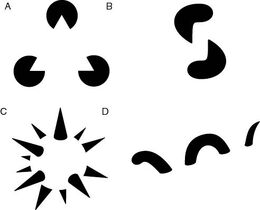
Reification
Reification is the constructive or generative aspect of perception, by which the experienced percept contains more explicit spatial information than the sensory stimulus on which it is based.
For instance, the human eye will see a triangle in picture A, although no triangle has actually been drawn.
Multistability
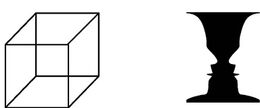
Multistability
Multistability (or Multistable perception) is the tendency of ambiguous perceptual experiences to pop back and forth unstably between two or more alternative interpretations. This is seen for example in the Necker cube, and in Rubin's Figure / Vase illusion shown to the right.
Invariance
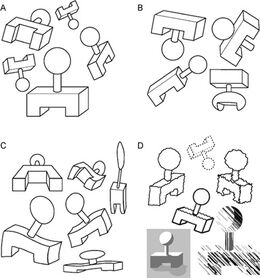
Invariance
Invariance is the property of perception whereby simple geometrical objects are recognized independent of rotation, translation, and scale, as well as several other variations such as elastic deformations, different lighting, and different component features. For example the objects in A in the figure are all immediately recognized as the same basic shape, which are immediately distinguishable from the forms in B. They are even recognized despite perspective and elastic deformations as in C, and when depicted using different graphic elements as in D.
Emergence, reification, multistability, and invariance, are not separable modules to be modeled individually, but they are different aspects of a single unified dynamic mechanism.
For a mathematical example of such a mechanism using the cubes of psychologists' block design tests, see Block Designs in Art and Mathematics and The Kaleidoscope Puzzle.
Origins
Although Max Wertheimer is credited as the founder of the movement, the concept of Gestalt was first introduced in contemporary philosophy and psychology by Christian von Ehrenfels (a member of the School of Brentano). The idea of Gestalt has its roots in theories by Johann Wolfgang von Goethe, Immanuel Kant, and Ernst Mach.
Both von Ehrenfels and Edmund Husserl seem to have been inspired by Mach's work Beiträge zur Analyse der Empfindungen (Contributions to the Analysis of the Sensations, 1886), in formulating their very similar concepts of Gestalt and Figural Moment, respectively.
Early 20th century theorists, such as Kurt Koffka, Max Wertheimer, and Wolfgang Köhler (students of Carl Stumpf) saw objects as perceived within an environment according to all of their elements taken together as a global construct. This 'gestalt' or 'whole form' approach sought to isolate principles of perception; seemingly innate mental 'laws', which determined the way in which objects were perceived.
These laws took several forms, such as the grouping of similar, or proximate objects together, within this global process. Although it has been criticised for being merely descriptive, it has formed the basis of much further research into the perception of patterns and objects (ref: Carlson, Buskist & Martin, 2000) and of research into behavior, thinking, problem solving and psychopathology.
Theoretical framework and methodology
The investigations developed at the beginning of the 20th century, based on traditional scientific methodology, divided the object of study into a set of elements that could be analyzed separately with the objective of reducing the complexity of this object. Contrary to this methodology, the school of Gestalt practiced a series of theoretical and methodological principles that attempted to redefine the approach to psychological research.
The theoretical principles are the following:
- Principle of Totality - The conscious experience must be considered globally (by taking into account all the physical and mental aspects of the individual simultaneously) because the nature of the mind demands that each component be considered as part of a system of dynamic relationships.
- Principle of psychophysical isomorphism - A correlation exists between conscious experience and cerebral activity.
Based on the principles above the following methodological principles are defined:
- Phenomenon Experimental Analysis - In relation to the Totality Principle any psychological research should take as a starting point phenomena and not be solely focused on sensory qualities.
- Biotic Experiment - The School of Gestalt established a need to conduct real experiments which sharply contrasted with and opposed classic laboratory experiments. This signified experimenting in natural situations, developed in real conditions, in which it would be possible to reproduce, with higher fidelity, what would be habitual for a subject.
Prägnanz

Law of Closure
The most basic rule of gestalt is the law of prägnanz. This law says that we try to experience things in as good a gestalt way as possible. In this sense, "good" can mean several things, such as regular, orderly, simplistic, symmetrical, etc. The other gestalt laws are:
- Law of Closure - Our mind adds missing elements to complete a figure.
- Law of Similarity - Our mind groups similar elements to an entity. The similarity depends on form, color, size and brightness of the elements.
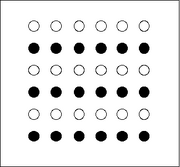
Law of Similarity
- Law of Proximity - Regional or chronological closeness of elements are grouped by our mind and seen as belonging together.
- Law of Symmetry - Symmetrical images are seen as belonging together regardless of their distance.
- Law of Continuity - The mind continues a pattern, even after it stops.
- Law of Common Fate - Elements with the same moving direction are seen as a unit.

Law of Proximity
Figure-ground minds have an innate tendency to perceive one aspect of an event as the figure or foreground and the other as the ground or the background.
Under the gestalt theory, these laws not only apply to images, but to thought processes, memories, and our understanding of time.
Examples of the Gestalt experience include the perception of an incomplete circle as a whole or a pattern of dots as a shape - the mind completes the missing pieces through extrapolation. Studies also indicate that simple elements/compositions where the meaning is directly perceived do not offer as much a challenge to the mind as complex ones and hence the latter are preferred over the former.
Relationship to Gestalt therapy
Gestalt psychology should not be confused with the Gestalt therapy of Fritz Perls, which is only peripherally linked to Gestalt psychology. A strictly Gestalt psychology based therapeutic method is Gestalt Theoretical Psychotherapy, developed by the German Gestalt psychologist and psychotherapist Hans-Juergen Walter.
See also
- structural information theory
- Wolfgang Metzger
- Kurt Goldstein
- Solomon Asch
- Fritz Perls
- Gestalt therapy
- James Tenney
- Graz School
- Important publications in gestalt psychology
- optical illusion
External links
- Receptions, Readings and Interpretations of Gestalt psychology - by Fiorenza Toccafondi
- Roy R. Behrens: Art, Design and Gestalt Theory
- Roy R. Behrens: Rudolf Arnheim: The Little Owl on the Shoulder of Athene
- 14th international Gestalt theory conference February 2005, Graz (Austria)
- Classical Gestalt psychology literature
- International Society for Gestalt Theory and its Applications - GTA
- Gestalt Theory - An International Multidisciplinary Journal
- Gestalt Theoretical Psychotherapy
- The gestalt therapy page
- The theory of gestalt therapy
- The World In Your Head - by Steven Lehar
- Gestalt Isomorphism and the Primacy of Subjective Conscious Experience - by Steven Lehar
- The new gestalt psychology of the 21st century
- Gestalt and Instructional Design
- Gestalt & Organizational Leadership
de:Gestalttheorie es:Psicología de la Gestalt eo:Geŝtalto fr:Psychologie de la forme lt:Geštalt psichologija nl:Gestaltpsychologie pt:Gestalt sv:Gestaltpsykologi zh:格式塔学派
| This page uses Creative Commons Licensed content from Wikipedia (view authors). |